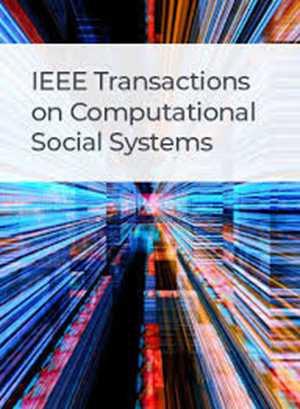针对交通传感器网络数据恢复的复合非凸低库张量补全与联合结构回归
IF 4.5
2区 计算机科学
Q1 COMPUTER SCIENCE, CYBERNETICS
IEEE Transactions on Computational Social Systems
Pub Date : 2024-06-17
DOI:10.1109/TCSS.2024.3406629
引用次数: 0
摘要
交通传感器网络可以方便地收集对智能交通系统(ITS)具有重要意义的交通数据。然而,数据缺失的普遍性阻碍了智能交通系统的应用,因此在实际应用中准确恢复缺失数据是必不可少的。通常情况下,底层交通张量数据存在全局低rankness和局部时空平滑性。有鉴于此,本文利用不完整张量中丰富的结构信息,提出了一种改进的低秩张量补全(LRTC)模型。具体来说,首先提出了对数幂复合(LPC)规范作为秩函数的非凸替代,从而灵活地表征了张量的多维相关性。然后,提出了一个联合结构回归(JSR)模型,以同时利用交通数据内在的时间连续性和轮廓相似性。通过这种方法,我们构建了一个新颖的非凸 LRTC 模型,该模型综合了全局低rankness 和细粒度时空结构,两者相辅相成。为了求解所提出的模型,我们遵循乘数交替法(ADMMs)的优化框架,开发了一种高效的迭代算法,其中每一步都能以封闭形式求解。我们在四个真实交通数据上进行了大量实验,以评估所提出方法的有效性。结果表明,与其他张量补全方法相比,我们的模型显著提高了恢复性能。本文章由计算机程序翻译,如有差异,请以英文原文为准。
Composite Nonconvex Low-Rank Tensor Completion With Joint Structural Regression for Traffic Sensor Networks Data Recovery
Traffic sensor networks allow convenient collection of travel data that are of great significance for intelligent transportation systems (ITSs). However, the universality of missing data impedes the application of ITS and thus accurate missing data recovery is indispensable in practice. Typically, the global low-rankness and local spatiotemporal smoothness exist in underlying traffic tensor data. In light of this, this article proposes an improved low-rank tensor completion (LRTC) model by exploiting abundant structural information from incomplete tensors. Specifically, a logarithm power composite (LPC)-norm is first proposed as a nonconvex substitute of the rank function, leading to a flexible characterization of tensor multidimensional correlation. Then, a joint structural regression (JSR) model is presented to simultaneously leverage the intrinsic temporal continuity and profile similarity of traffic data. By doing so, we construct a novel nonconvex LRTC model by integrating the global low-rankness and fine-grained spatiotemporal structure that are complementary to each other. To solve the proposed model, following the optimization framework of the alternating direction method of multipliers (ADMMs), we develop an efficient iterative algorithm where each step can be solved in a closed form. Extensive experiments on four real-world traffic data are conducted to evaluate the effectiveness of the proposed approach. The results demonstrate that compared with other tensor completion methods, our model significantly improves the recovery performance.
求助全文
通过发布文献求助,成功后即可免费获取论文全文。
去求助
来源期刊

IEEE Transactions on Computational Social Systems
Social Sciences-Social Sciences (miscellaneous)
CiteScore
10.00
自引率
20.00%
发文量
316
期刊介绍:
IEEE Transactions on Computational Social Systems focuses on such topics as modeling, simulation, analysis and understanding of social systems from the quantitative and/or computational perspective. "Systems" include man-man, man-machine and machine-machine organizations and adversarial situations as well as social media structures and their dynamics. More specifically, the proposed transactions publishes articles on modeling the dynamics of social systems, methodologies for incorporating and representing socio-cultural and behavioral aspects in computational modeling, analysis of social system behavior and structure, and paradigms for social systems modeling and simulation. The journal also features articles on social network dynamics, social intelligence and cognition, social systems design and architectures, socio-cultural modeling and representation, and computational behavior modeling, and their applications.
 求助内容:
求助内容: 应助结果提醒方式:
应助结果提醒方式:


